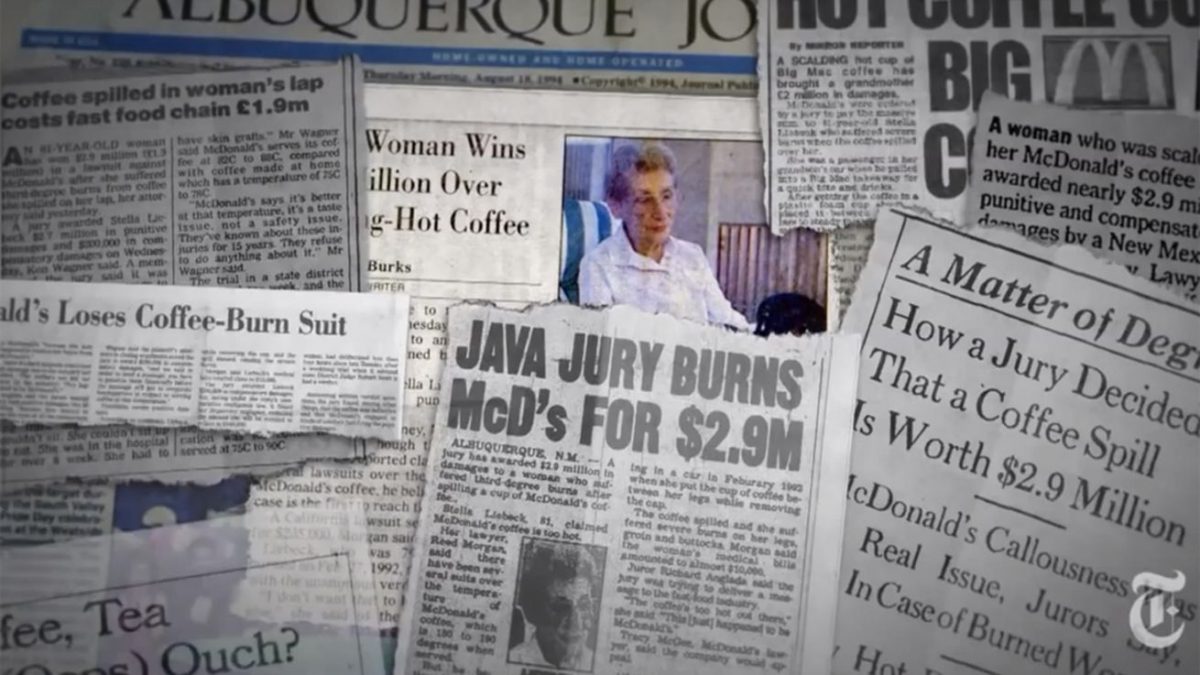Pain and Suffering and the McDonald’s Coffee Case
Pain and Suffering and the McDonald’s Coffee Case
 Last week, a young woman hired me to represent her on a case in which she was injured when she was hit by a car. The incident occurred while she was walking to work. As she was walking on the shoulder of a road near the parking lot of a local business, a car suddenly darted out of the parking lot, crossed two lanes of traffic, and hit her. The front bumper of the car hit her on the right side of her knee, causing her to fall and hit her head on the ground.
Last week, a young woman hired me to represent her on a case in which she was injured when she was hit by a car. The incident occurred while she was walking to work. As she was walking on the shoulder of a road near the parking lot of a local business, a car suddenly darted out of the parking lot, crossed two lanes of traffic, and hit her. The front bumper of the car hit her on the right side of her knee, causing her to fall and hit her head on the ground.
After the impact, the driver of the car stopped her car, looked at the woman while she was trying to get up from where she had fallen, and then fled the scene of the accident. Fortunately for the woman, she had the presence of mind to look at the license plate number of the car as it sped away. She then pulled her cell phone out of her pocket and typed in the license number of the vehicle.
The incident happened at around 7:30 in the morning in an area where there was a minimal amount of traffic. After being hit, the woman walked a couple of blocks to her place of employment. While she was walking, she had severe pain in her right knee and throbbing pain in her head. When she arrived at her place of employment, she explained what had happened to a fellow employee. The employee made her sit down to take the pressure off her knee.
The women then dialed 911 and reported the incident to the police department. Shortly thereafter, a police officer and an ambulance arrived. A collar was placed around her neck, and she was put on a stretcher. She was then transported to the emergency room of one of the local hospitals. A CT scan of her head was taken, and her right knee was X-rayed.
The results of the CT scan were normal, and the X-ray did not indicate that there were any broken bones. While she was at the hospital, the police officer stopped by and told her that he had been able to use the license plate number to identify the driver of the vehicle. He said that he talked to the driver at her home and gave her two traffic citations.
Earlier this year, another young woman hired me to represent her after she was hit by a vehicle. The incident occurred while she was crossing the street at an intersection. At the time of the incident, she was in the crosswalk and had the “Walk” message. The car that hit her was being driven by a business professional who was talking on her cell phone while she was driving.
The driver didn’t see the woman when she turned left at the intersection. The front of the car hit the woman’s right side, causing the women to flip up onto the hood of the car. She then fell onto the street with such force that her head hit the pavement. As a result of the collision, the woman injured her knee, had bruises on her right leg and hip, and also had a severe headache.
The woman was checked out at the hospital and was subsequently fitted with a custom knee brace. She is currently receiving therapy to reduce the swelling and stiffness in her knee. She is scheduled to have surgery on her knee next month.
With both of the cases that I just described, because of the negligence (carelessness) of the drivers of the vehicles, both of my clients are legally entitled to reimbursement of their medical bills, lost wages for the time that they are unable to work, and other expenses that are related to their injuries. They are also entitled to receive compensation for their present and future pain and suffering. If they do not fully recover from their injuries, they will also be entitled to compensation for their future estimated medical bills.
While the women’s injury claims are against the drivers of the vehicles, it will be the responsibility of the insurance companies that insured the vehicles to pay a lump sum settlement after the women have completed their treatment. If the insurance companies are willing to be reasonable, settlements will be achieved on both cases and a lump sum payment will be made on each case to compensate the women for their injuries.
If the insurance companies are not willing to be reasonable, a lawsuit will have to be filed against the drivers of the vehicles and the insurance companies will then be required to hire a law firm to defend the cases.
One to the difficulties that lawyers have in settling injury cases is that unless there are catastrophic injuries in which a person is severely injured (broken bones, deformities, etc.), insurance companies place very little value on the pain and suffering component of each case. The primary reason for this is because when injury cases are actually filed in court and presented to a jury of 12 people, the individuals on the jury do not ordinarily place a high value on pain and suffering, unless there were severe injuries.
One of the problems that lawyers have in asking jurors to place a high value on pain and suffering is that the jurors have been conditioned throughout their lives to believe that our system of justice unfairly rewards people who falsely claim that they have been injured. For jurors who are over the age of 50, the case that is always used in their minds as justification for discounting a person’s pain and suffering is the McDonald’s coffee case.
The McDonald’s coffee case received national attention in 1994 when a jury awarded $2.9 million in punitive (punishment) damages to an 81-year-old woman who had suffered from third-degree burns on her legs after spilling a cup of scalding hot coffee that had been purchased from a McDonald’s drive-thru in Albuquerque, New Mexico.
The evidence in that case showed that the McDonald’s operations manual required that its coffee be heated to 180 to 190 degrees Fahrenheit and that over a period of 10 years, there had been more than 700 reported cases in which customers had suffered from third-degree burns because of spilled coffee. The jury awarded punitive damages because of McDonald’s callous disregard for its customers.
Even though McDonald’s was aware of the danger that its customers were exposed to, it failed to reduce the temperature of its coffee and failed to notify its customers of the severe danger of its scalding hot coffee. The $2.9 million award was the equivalent of two days of national profits from the sale of McDonald’s coffee. The woman’s lawyer had offered to settle the case for $20,000 before the trial and McDonald’s refused to pay that amount to get the case settled. The $2.9 million jury verdict was reduced after trial by the judge by 80 percent.
After the McDonald’s coffee verdict, insurance companies and the media hammered away at how our system of justice was broken and was costing consumers millions of dollars in additional insurance premiums. Their primary message to the public was that people were using the court system as a lottery in which they could cash in if they successfully claimed that they had been injured.
Today’s jurors and judges are suspicious and cynical about individuals who come into court and ask for compensation for injuries. Many of them have bought into the argument that if they award a lot of money to an injured person, their insurance premiums will go up and so-called injured people will be rewarded for their dishonesty.
These are the factors that I have to consider when I present a case to a jury. If I have a client who was legitimately injured and has not fully recovered from their injuries, what can I do to overcome the long-established bias and opinions of jurors who have been conditioned to believe that most people are faking their injuries, so they can get money from a jury? How am I supposed to overcome the negative thoughts that are going through jurors’ minds when they are listening to testimony that my client is still experiencing pain from an injury that took place two or three years ago?
I’ve made it a practice to specifically address these issues during the case and during my closing argument. I actually stand in front of the jury and discuss the McDonald’s coffee case and how the case should not have any impact on the compensation that my client is entitled to receive. I also spend a good amount of time discussing how pain differs from suffering and what the impact of both pain and suffering is on my client’s life.
Next week, I’m going to explain how I present the topic of pain and suffering to a jury and how pain is different from suffering. I’m going to also discuss how suffering is an integral and important part of every person’s life, how society generally views suffering as an evil, and why devout Catholics view suffering as a necessary component of salvation.





1 Comment
[…] Last week, I wrote about a client who was hit by a car while she was crossing the street, and another client who was hit by a car while she was walking on the side of the road. I explained that under Illinois law, the two women are entitled to reimbursement of their medical bills, lost wages for the time that they are unable to work, and other expenses that are related to their injuries. They are also entitled to receive compensation for their present and future pain and suffering. I also discussed the McDonald’s coffee case and explained the difficulty that lawyers have in presenting the topic of pain and suffering to a jury. Today, I’m going to discuss how I explain to a jury the “value” of a person’s pain and suffering. […]